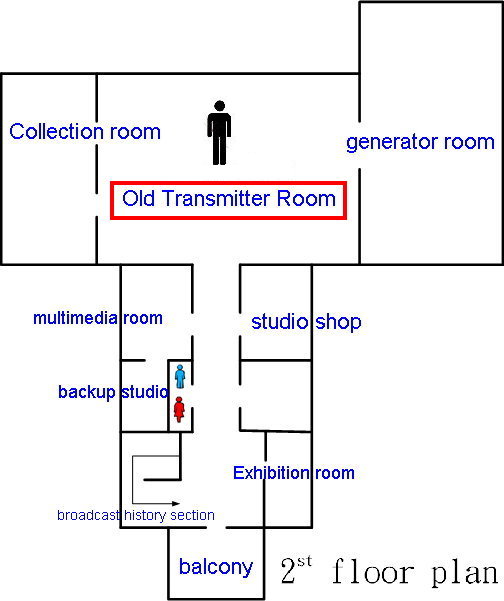| |
|
|
|
|
others |
|
cooling system section |
 |
|
|
Cooling System Room |
Cooling System |
 |
 |
|
The cooling system on first floor worked
with the transmitter on second floor as
a whole. During colonial period, there
was no piped water available for
Minsyong Broadcast Center, which had to
pump underground water and stored it in
buckets for later distilling as a
solution. The water distilled would be
pumped up to the transmitter to cool the
tube and other components so that the
machines wouldn’t break down for being
too hot. |
Distilled water is required to cool the
vacuum tube of MB-15-A100KW after it
operated for a while. As the picture on
the wall reveals, the water boiled goes
down to the green reservoir on first
floor through the pink pipes, and the
yellow pipes contains underground water
that comes from the giant reservoir
outside the museum. The water boiled
will be cooled in the green bucket by
underground water first and then pumped
back to second floor to cool the
transmitter. |
|
|
 |
|
|
|
Cooling System for
MLB-15-A100kW Medium Wave Transmitter: |
|
|
|
The reservoir is a key part of the cooling
system. Aside from cleaning water, it also holds
a great amount of water for cooling. The old
filter tower, pump room and the reservoir were
all built for cooling transmitters. Underground
water was the main source of water around
Minsyong area then, and the filter tower was to
clean the water so that the machine wouldn’t get
stuck by the sands in the liquid and the staff
could be provided with clean water. The tower
has an ingenious design on the rim of its
opening, which keeps water from spilling out and
receives adequate sunlight to suppress moss from
growing. |
|
|
 |
|
|
|
Ceramic Buffering Tubes: |
 |
 |
|
The winding ceramic tubes were aimed to kept
water from gushing into the transmitters. |
|
|
 |
| |
|
Exhibition Room:
Golden Bell Awards, the Dream Awards for
Broadcasters |
 |
|
 |
|
The Golden Bell Awards, founded in 1965, is an
annual Taiwanese television and broadcast
production award. It is synonymous with The Emmy
Awards of the U.S. Over the years, Radio Taiwan
International has clinched numerous awards for
the programs it produces. |
|
| |
|
Press Pass – The
Access to All |

|
|
 |
|
In occasions such as Celebration of National
Day, Presidential Inauguration Ceremony and so
forth, journalists will be given press passes
that grant some privileges, for example, full
access around the area. The most aged pass that
you can find here is the one written with
chinese brushes and issued in 1957. The pass
issued by World Anti-Communist League (WACL) is
also among the collection. |
|
| |
|
QSL Card (A confirm
to transmission receipt). The precious
to listeners |
 |
|
 |
|
When foreign
listeners send the radio feedbacks,
regarding time spent listening,
frequency, signals quality, and some
suggestions for programs, the radio will
reply with a QSL card in appreciation to
their advice. A QSL card is virtually a
certificate to one’s listening to the
broadcast. A lot of peolple enjoys
listening to broadcast and collecting
QSL cards from radios worldwide. |
|
|
 |
| |
|
Studio shop |

|
|
 |
|
The studio gives you the fun of being a
DJ! Equipped with double-panel sound
proof glasses, the studio has mixers,
computers and DVD players, which are
essential tools in the project “Voice
Bank” and summer camps held by the Radio
Museum. |
|
| |
|
The Voice Bank |

|
|
 |
|
Make your voice an everlasting
collection! In 2007, the National Radio
Museum established the Voice Bank, where
everyone can open up an account and
store the voices in different phases of
their lives. |
|
|
 |
| |
| |
|
Console Desk |
 |
|
 |
|
Manipulate sound
waves easily! The staff does all the
settings from switching on off the power
to broadcasting by the console table. |
|
|
 |
|
|
|
Collection room |
 |
|
|
Spreading Propagandas in China |
Anti-Communists Movements |
Spreading Propagandas in China |
|
In 1982, psychology operations toward
China were still being carried out. It
was the script then. |
In 1969, psychology operations toward China were
still being carried out. It was the script then. |
In 1968, psychology operations toward
China were still being carried out. It
was the script then. |
|
 |
|
The Scripts, no errors
allowed! : The anchors living in the 50s were
not able to speak in programs as freely as their
counterparts today. They were required to read
along the scripts that were choreographed in
advance. These are the scripts then. |
|
|
|
|
Radio License |
The Taiwan Broadcasting Journal |
The Construction Report of Minsyong
Broadcast Center |
|
A license for the MB-15-A 100KW medium
wave transmitter. It equals to a license
for transmission today. |
An issue of the Journal and
an extra edition published in 1942.
|
Records and data with
respect to the radio’s construction.
|
|
 |
|
The Radio Log– Memories of
the Past: the log written by the staff of the
radio. |
|
|
 |
| |